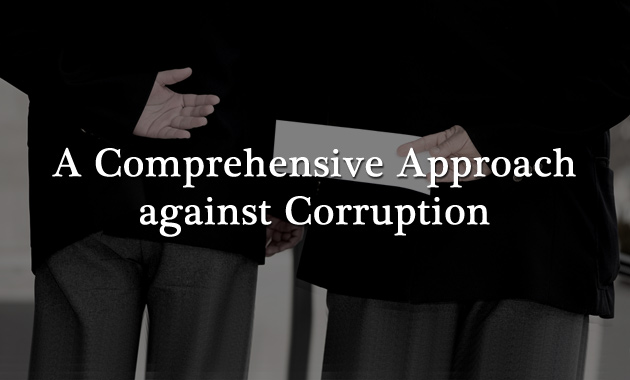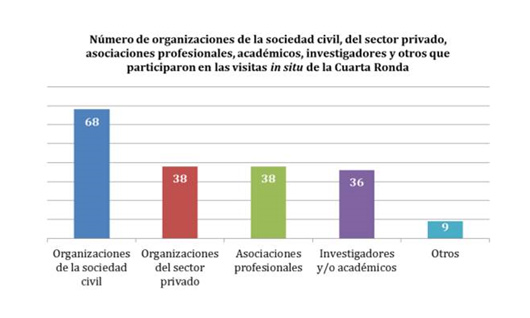- English
- Español
Media Center
Feature

The Mechanism for Follow-up on the Implementation of the Inter-American Convention against Corruption (MESICIC) is the OAS anti-corruption instrument.
The MESICIC is a peer-review mechanism: countries evaluate other countries.
The current Round of Review evaluates transparency in public sector hiring systems, the procurement of goods and services, and the protection of whistleblowers.
March 4, 2016
During their visit to Peru last September, anti-corruption authorities from Mexico and Nicaragua had a very busy agenda between meetings, evaluations, and review of documents, laws, manuals, and government structures. They met with civil society organizations, the private sector representatives, professional, academic and research associations, as well as public officials responsible for implementing the law. In just three days, they collected all the information, along with the survey of the High-Level Anticorruption Commission authorities that would allow them to examine how Peru has made progress in areas related to the fight against corruption.
These in-situ visits take place every year in several countries of the region and are at the core of the evaluations that the MESICIC carries out. The visits allow experts to gather information, gain an appreciation of the situation of anti-corruption efforts in countries, and give them a broad perspective in order to carry out evaluations. Anticorruption experts from evaluating countries participate in these visits and have previously been approved by the country receiving them.
How does it work?
“Strengthening cooperation to fight corruption more effectively is a priority for the OAS: it is included in the new Strategic Vision of the Organization, and this administration firmly believes in this cause. Integrity, transparency, and accountability are the very essence of the kinds of policies that allow a democratic system to work properly.”
Luis Almagro
OAS Secretary General
The Mechanism is organized into a system of “rounds” in each of which a different aspect of corruption is addressed. All countries are evaluated, and all countries are involved in the evaluation of others. The result of this dynamic is compiled into reports aimed at helping each country to identify shortcomings and to correct areas that still need improvement. The peer evaluation, or inter pares process, is based on the concept of impartiality and objectivity in which there are no sanctions or judgments, but rather a spirit of mutual and shared commitment and equality.
The recommendations arising from the “rounds of review” have had a direct and positive impact on participating countries. Thanks to the recommendations of the Mechanism, it has been possible to pass laws and/or implement measures aimed at strengthening the legal and institutional frameworks used by states to address corruption, among them:
- The “Marcelo Quiroga Santacruz” Law to Combat Corruption (Bolivia);
- The Corruption of Foreign Public Officials Act (Canada);
- The Law against Corruption and Illicit Enrichment Regulations (Costa Rica);
- The Law on Access to Information (Guyana);
- The Law on the Prevention and Suppression of Corruption (Haiti);
- The Ethics in Government Act (El Salvador);
- The Federal Anticorruption Law in Public Procurement (Mexico); and
- The Decree on Standards of Conduct in Public Service (Uruguay).
Since its inception in 2001, the MESICIC has finalized four rounds of review during which different aspects of the problems were addressed, including:
- Prevention of conflicts of interest;
- Preservation of public resources;
- Government procurement;
- Links between public servants and asset disclosure systems;
- Participation of civil society in fighting corruption;
- Controls of businesses to detect and prevent corrupt practices;
- Criminalization of acts of corruption;
- Transnational bribery and illicit enrichment;
- Whistleblowers’ protection; and
- Oversight bodies.
A Participative and Inclusive Process
The Inter-American Convention against Corruption , adopted in Caracas, Venezuela, in 1996 is the first international anticorruption instrument to establish a guide on how to prevent, detect, punish, and eradicate corruption from the public realm. It is basically an intergovernmental exercise, but it offers ample space for civil society participation. That is why the MESICIC is perceived as a strategy with shared responsibilities: those of the states; the private sector; civil society; and the international community.
The OAS Anticorruption Mechanism in numbers:

- The Inter-American Convention against Corruption has been ratified by 33 of 34 member states; it is the most ratified Inter-American treaty after the Charter of the OAS. It is hoped that Barbados will ratify the Convention, which would give it a universal character in the Hemisphere.
- The MESICIC has completed four rounds of review, during which 114 national reports were adopted.
- Since its inception in 2013, 30 on site visits have been carried out in as many member states.
- During the Fourth Round of Review, which concluded in 2014, 139 major oversight bodies responsible for preventing, investigating and punishing acts of corruption were evaluated.
- At the time of its creation, 20 countries participated in the First Round of Review; that number currently stands at 31.
The Fifth Round’s evaluation processes are already underway, and the respective visits have already been carried out in four countries as part of this new chapter. In this round, the MESICIC will evaluate progress made by states in issues related to transparency in public servant hiring systems, the procurement of goods and services, and the protection of those who in good faith report acts of corruption–matters of the utmost importance for the region.
Reference: E-026/16


